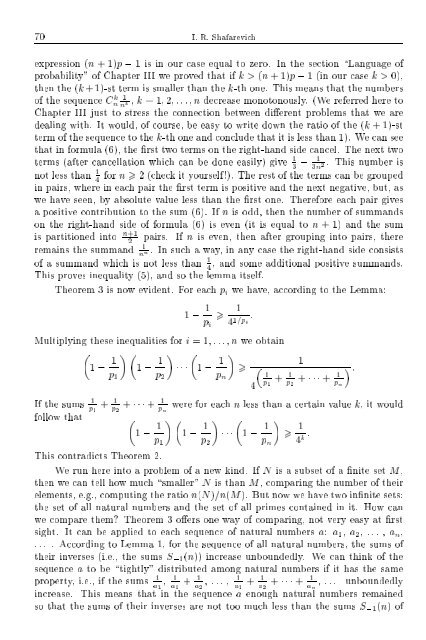SELECTED CHAPTERS FROM ALGEBRA I. R. Shafarevich Preface
SELECTED CHAPTERS FROM ALGEBRA I. R. Shafarevich Preface
SELECTED CHAPTERS FROM ALGEBRA I. R. Shafarevich Preface
Create successful ePaper yourself
Turn your PDF publications into a flip-book with our unique Google optimized e-Paper software.
70 I. R. <strong>Shafarevich</strong>expression (n +1)p ; 1 is in our case equal to zero. In the section \Language ofprobability" of Chapter III we proved that if k>(n +1)p ; 1 (in our case k>0),then the (k + 1)-st term is smaller than the k-th one. This means that the numbersof the sequence Cn k 1n k , k =1 2 ...n decrease monotonously. (We referred here toChapter III just to stress the connection between dierent problems that we aredealing with. It would, of course, be easy to write down the ratio of the (k + 1)-stterm of the sequence to the k-th one and conclude that it is less than 1). We can seethat in formula (6), the rst two terms on the right-hand side cancel. The next twoterms (after cancellation which can be done easily) give 1 3 ; 13n. This number is2not less than 1 for n > 2(check ityourself!). The rest of the terms can be grouped4in pairs, where in each pair the rst term is positive and the next negative, but, aswe have seen, by absolute value less than the rst one. Therefore each pair givesa positive contribution to the sum (6). If n is odd, then the number of summandson the right-hand side of formula (6) is even (it is equal to n +1) and the sumis partitioned into n+1 pairs. If n is even, then after grouping into pairs, there2remains the summand 1n n . In such away, inany case the right-hand side consistsof a summand which is not less than 1 , and some additional positive summands.4This proves inequality (5), and so the lemma itself.Theorem 3 is now evident. For each p i wehave, according to the Lemma:1 ; 1 p i> 14 1=pi :Multiplying these inequalities for i =1 ...n we obtain1 1 ;1 1 ; 1 11; > :p 1 p 2 p n 1p4 1+ 1 p 2+ + 1p nIf the sums 1 p 1+ 1p 2+ + 1p nwere for each n less than a certain value k, itwouldfollow that 1 1 ;1 1 ; 1 1; > 1p 1 p 2 p n 4 k :This contradicts Theorem 2.We run here into a problem of a new kind. If N is a subset of a nite set M,then we can tell how much \smaller" N is than M, comparing the number of theirelements, e.g., computing the ratio n(N)=n(M). But now wehave two innite sets:the set of all natural numbers and the set of all primes contained in it. How canwe compare them? Theorem 3 oers one way of comparing, not very easy at rstsight. It can be applied to each sequence of natural numbers a: a 1 , a 2 , ... , a n ,... . According to Lemma 1, for the sequence of all natural numbers, the sums oftheir inverses (i.e., the sums S ;1 (n)) increase unboundedly. We can think of thesequence a to be \tightly" distributed among natural numbers if it has the sameproperty, i.e., if the sums 1 1a 1,a 1+ 1 1a 2,...,a 1+ 1 a 2+ + 1a n,... unboundedlyincrease. This means that in the sequence a enough natural numbers remainedso that the sums of their inverses are not too much less than the sums S ;1 (n) of
















